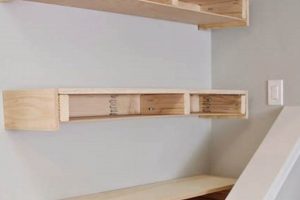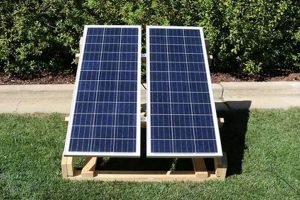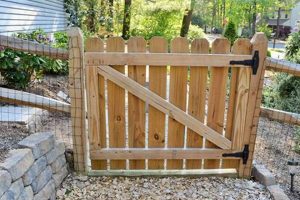The act of installing screening on an open-air porch area through individual effort, often involving material selection, frame construction or modification, and screen attachment, represents a practical approach to home improvement. This process contrasts with hiring professional services, relying instead on the homeowner’s abilities and resourcefulness.
Undertaking such a project yields multiple advantages. It offers potential cost savings compared to professional installation. Furthermore, it allows for customized design choices tailored to specific aesthetic preferences and functional needs. Historically, this type of project reflects a tradition of self-reliance and home maintenance common across various cultures.
The subsequent discussion will detail essential considerations for planning and executing this project, including material selection, framing techniques, screen installation methods, and strategies for ensuring a durable and aesthetically pleasing final product.
Practical Guidance for Porch Screening Implementation
The following recommendations are designed to assist in the successful completion of a porch screening endeavor. Adherence to these principles can contribute to a durable, functional, and visually appealing result.
Tip 1: Accurate Measurement is Paramount: Prior to material acquisition, precise dimensions of the porch opening are critical. Discrepancies in measurement can lead to material wastage and compromised structural integrity of the screen frame.
Tip 2: Select Durable Screening Material: The choice of screening material influences longevity and resistance to environmental factors. Fiberglass screening is a common and economical option, while aluminum screening offers greater durability against pet damage and weather exposure.
Tip 3: Frame Construction Considerations: If constructing a new frame, utilize pressure-treated lumber or aluminum for resistance to moisture and decay. Ensure square and level construction for proper screen tension and a professional appearance.
Tip 4: Secure Screen Attachment: Several methods exist for attaching the screening to the frame. Spline systems provide a clean, taut finish. Alternatively, staples or tacks may be employed, but require careful application to prevent tearing or sagging.
Tip 5: Account for Expansion and Contraction: When using wooden frames, allow for slight expansion and contraction due to temperature and humidity fluctuations. This can be achieved by leaving small gaps or using flexible fasteners.
Tip 6: Proper Tensioning Techniques: Consistent tension across the entire screen surface is crucial. Avoid over-stretching, which can lead to tearing or frame distortion. Uniform tension provides a professional and functional result.
Tip 7: Sealing and Weatherproofing: After installation, consider sealing the frame with a weather-resistant sealant to protect it from the elements. This extends the life of the installation and prevents moisture damage.
These guidelines emphasize the importance of meticulous planning and execution. Attention to detail throughout the project will lead to a finished product that enhances the usability and enjoyment of the porch area.
The subsequent section will address common challenges encountered during porch screening and offer solutions for overcoming these obstacles.
1. Material durability
The durability of materials employed in screening projects directly influences the longevity and overall performance of the finished enclosure. The selection of appropriate materials serves as a foundational element for ensuring the structure withstands environmental stressors and remains functionally sound over time. Ineffective material selection leads to premature deterioration, requiring frequent repairs or complete replacement of the screening. The link between the materials’ longevity and the ultimate success of screening endeavors is, therefore, inextricable.
For instance, fiberglass screening, while economically advantageous, may prove susceptible to damage from exposure to ultraviolet radiation and physical abrasions. Conversely, aluminum screening offers enhanced resistance to these factors, contributing to an extended service life, particularly in regions with harsh climatic conditions. The consequence of choosing a less durable material, such as insect netting, is the likelihood of needing replacement within a shorter timeframe, negating the initial cost savings and potentially increasing overall project expense. Similarly, the framing material’s resistance to rot and insect infestation is a critical factor impacting long-term structural integrity.
In conclusion, when undertaking a project, the selection of durable materials emerges as a paramount consideration. It directly dictates the project’s cost-effectiveness, aesthetic appeal, and overall lifespan. A thorough assessment of environmental factors and anticipated wear and tear is essential to inform the selection process, thereby ensuring a satisfactory and sustainable outcome. Neglecting material durability can undermine the entire project, resulting in diminished performance and increased maintenance burdens.
2. Frame construction
Frame construction is a critical component of successfully implementing a screened porch. The frame provides the structural support and defines the boundaries for the screening material. Proper frame construction dictates the overall stability, appearance, and longevity of the screened enclosure. Inadequate frame construction compromises the screening’s integrity and necessitates repairs or complete replacement.
- Material Selection and Durability
The choice of framing material significantly impacts the structure’s ability to withstand environmental factors. Pressure-treated lumber, aluminum, or composite materials are commonly used due to their resistance to moisture, insect damage, and decay. Selecting inappropriate materials leads to premature failure, requiring costly replacements. Examples include untreated wood rotting and aluminum corroding in coastal environments.
- Structural Integrity and Design
Proper framing techniques, including secure joinery and adequate support bracing, are essential for maintaining structural integrity. The frame must be capable of withstanding wind loads, snow accumulation, and other environmental stresses. Designing the frame to accommodate screen tension and expansion/contraction is also critical. Deviations from established building practices results in structural instability and potential collapse.
- Attachment Methods and Integration
The manner in which the screening material is attached to the frame directly affects the system’s overall performance. Spline systems, staples, or tacks are employed to secure the screen within the frame. The chosen me
thod must provide a tight, uniform hold that resists tearing and sagging. Improper attachment leads to screen detachment and insect ingress. The frame construction needs to consider and accomodate the selected attachement system. - Aesthetic Considerations and Finishing
The frame’s visual appearance contributes significantly to the overall aesthetic of the screened porch. Smooth, even surfaces, consistent joinery, and a professional finish enhance the structure’s visual appeal. Applying paint, stain, or sealant protects the frame from the elements and complements the surrounding architectural style. Neglecting aesthetic considerations results in a visually unappealing and potentially devalued structure.
These facets of frame construction are inextricably linked and play a pivotal role in the success of screening. While material cost and ease of installation can seem important, ignoring the core aspects such as structural design can potentially lead to a poor construction. A DIY screening project is only as good as its frame.
3. Accurate measurement
Accurate measurement forms the foundation of a successful screened porch project. Dimensional precision directly influences material acquisition, frame construction, and the ultimate fit and finish of the screen enclosure. Inaccurate measurements initiate a cascade of complications, potentially resulting in material waste, structural instability, and aesthetic compromises. The significance of this initial step cannot be overstated, as it dictates the efficiency and effectiveness of subsequent stages.
A common consequence of imprecise measurement is the undersizing or oversizing of materials. For instance, if the porch opening is incorrectly measured, the acquired screening material may prove insufficient to cover the entire area. Conversely, excessive material purchase translates to unnecessary expense and potential disposal challenges. Frame construction also suffers from inaccurate dimensions. A frame built too small leaves gaps, allowing insects to infiltrate, while an oversized frame requires extensive modification or complete reconstruction. Real-world scenarios frequently involve correcting for measurement errors through the use of shims, fillers, or recutting lumber, adding time and cost to the project. Failure to account for plumb and square conditions during measurement can lead to skewed frame assemblies and uneven screen tension.
In conclusion, accurate measurement is paramount for any porch screening project. The cost associated with precision at the outset is significantly less than the expense and frustration of rectifying errors stemming from inaccurate data. The investment in a quality measuring device and the diligence to verify dimensions repeatedly contributes directly to a superior final product. Therefore, meticulous measurement serves not merely as a preliminary step, but as a critical determinant of project success, minimizing material waste and maximizing long-term performance.
4. Proper installation
The term “proper installation,” when contextualized within “diy screening a porch,” refers to the correct and proficient application of techniques and procedures necessary to affix screening material to a porch structure. This encompasses several factors, including adequate tensioning of the screen, secure attachment to the frame, and meticulous sealing of edges to prevent insect ingress. Improper installation frequently leads to sagging screens, torn material, and gaps that negate the intended purpose of insect protection. The cause-and-effect relationship is direct: insufficient adherence to recommended installation practices results in a compromised barrier and a diminished aesthetic outcome. The importance of this element is underscored by its direct impact on the screened porch’s functionality and durability.
Consider a scenario where a homeowner, attempting a screening project, fails to adequately tension the screen material during installation. The resulting sag creates an unsightly appearance and weakens the screen, making it more susceptible to damage from wind, debris, or even casual contact. Furthermore, if the homeowner neglects to properly secure the edges of the screen to the frame, gaps appear, providing entry points for insects. These examples illustrate the practical significance of understanding and implementing proper installation techniques. The lack of secure staples, incorrect use of spline, or poorly aligned screen corners compromises the entire effort. Another frequent error involves using the wrong type of fasteners, leading to corrosion and ultimately screen failure.
In summary, proper installation is not merely a procedural step in the context of a do-it-yourself porch screening project; it is a crucial determinant of the project’s success. Addressing challenges such as uneven framing or difficult-to-reach areas requires careful planning and execution. By prioritizing proper installation techniques, the homeowner increases the likelihood of a durable, functional, and aesthetically pleasing screened porch, thereby realizing the full benefits of the undertaking and contributing to long term value of the residence. Conversely, overlooking this aspect undermines the entire endeavor.
5. Weatherproofing
Weatherproofing constitutes an essential phase in the successful completion of any screened porch project. It is the process of protecting the structure and its components from the deleterious effects of exposure to environmental elements. The implementation of effective weatherproofing measures extends the lifespan of the screen enclosure, reduces maintenance requirements, and preserves its aesthetic integrity.
- Frame Sealing and Protection
The perimeter frame of the screened porch is particularly vulnerable to moisture intrusion. Applying a high-quality sealant or paint to the frame creates a protective barrier against rain, snow, and humidity. Failure to properly seal the frame leads to wood rot, corrosion (in the case of metal frames), and structural weakening. For example, untreated lumber exposed to consistent moisture can experience significant decay within a few years.
- Screen Attachment Point Sealing
The points where the screening material is attached to the frame are potential entry points for water and air infiltration. Properly sealing these areas with caulk or weather stripping prevents drafts and water damage, and impedes insect passage. Inadequate sealing contributes to energy loss, discomfort, and allows insects to penetrate the screened enclosure.
- Foundation and Sill Plate Protection
Where the porch structure meets the foundation, or where the sill plate is exposed, thorough weatherproofing is essential. Applying a moisture barrier or sealant to these areas prevents water from wicking up into the structure, causing rot and structural damage. Improper sealing at the foundation level necessitates costly repairs to the porch structure and potentially to the home’s foundation.
- Drainage Considerations
Proper drainage around the screened porch prevents water accumulation and reduces the risk of flooding or water damage. Ens
uring adequate slope away from the structure and installing gutters or downspouts to divert rainwater minimizes the exposure of the porch to standing water. Poor drainage accelerates deterioration of the structure’s components and creates favorable conditions for mold and mildew growth.
The effectiveness of weatherproofing directly impacts the long-term performance and value of the screened porch. A properly weatherproofed structure resists deterioration, maintains its aesthetic appeal, and provides a comfortable and insect-free outdoor living space. Conversely, neglecting weatherproofing measures results in a shortened lifespan and increased maintenance demands.
Frequently Asked Questions
The following addresses common inquiries and concerns associated with constructing or renovating a screened porch. The information provided is intended to clarify best practices and mitigate potential challenges.
Question 1: What is the optimal screening material for resisting pet damage?
While fiberglass screening offers a cost-effective solution, aluminum screening provides superior resistance to damage inflicted by pets. Consider the added durability of aluminum if pets have access to the screened area.
Question 2: How can accurate measurements be ensured when a porch lacks perfectly square corners?
Measure diagonally across the porch opening, in addition to length and width. This reveals discrepancies indicating out-of-square conditions, requiring adjustments during frame construction to compensate for angular variations.
Question 3: What is the recommended method for attaching screening to a wooden frame?
A spline system provides a professional and secure attachment. Alternatively, staples or tacks can be used, but ensure they are corrosion-resistant and applied with uniform spacing to maintain screen tension.
Question 4: How can sagging screens be prevented over time?
Proper tensioning during installation is crucial. Additionally, select a higher-quality screening material and consider installing support bars within the frame to minimize sagging across large spans.
Question 5: What type of sealant is best suited for weatherproofing a screened porch frame?
A paintable, exterior-grade acrylic latex caulk with silicone additives offers excellent adhesion and flexibility to accommodate expansion and contraction due to temperature fluctuations. Ensure the sealant is compatible with the frame material.
Question 6: How often should a screened porch be inspected for maintenance needs?
Conduct a thorough inspection at least twice annually, preferably in the spring and fall. Check for damaged screens, loose frame connections, and deterioration of weatherproofing materials.
These frequently asked questions highlight essential aspects of porch screening. Adhering to these guidelines can minimize common problems and contribute to a durable and aesthetically pleasing outcome.
The subsequent discussion will focus on the tools and equipment required to successfully complete this project.
Concluding Remarks
This exploration of the concept “diy screening a porch” has underscored the critical factors influencing project success, including material selection, frame construction, accurate measurement, proper installation techniques, and robust weatherproofing strategies. Attention to detail within each of these domains dictates the ultimate functionality, longevity, and aesthetic appeal of the completed screened enclosure.
Therefore, prospective individuals undertaking a project of this nature should approach the task with meticulous planning and a commitment to adhering to established best practices. Diligence in these areas not only ensures a satisfactory outcome but also contributes to the long-term value and enjoyment of the outdoor living space. Future developments in materials and techniques may further enhance the accessibility and durability of screened porches, but the fundamental principles outlined herein remain paramount to success.







